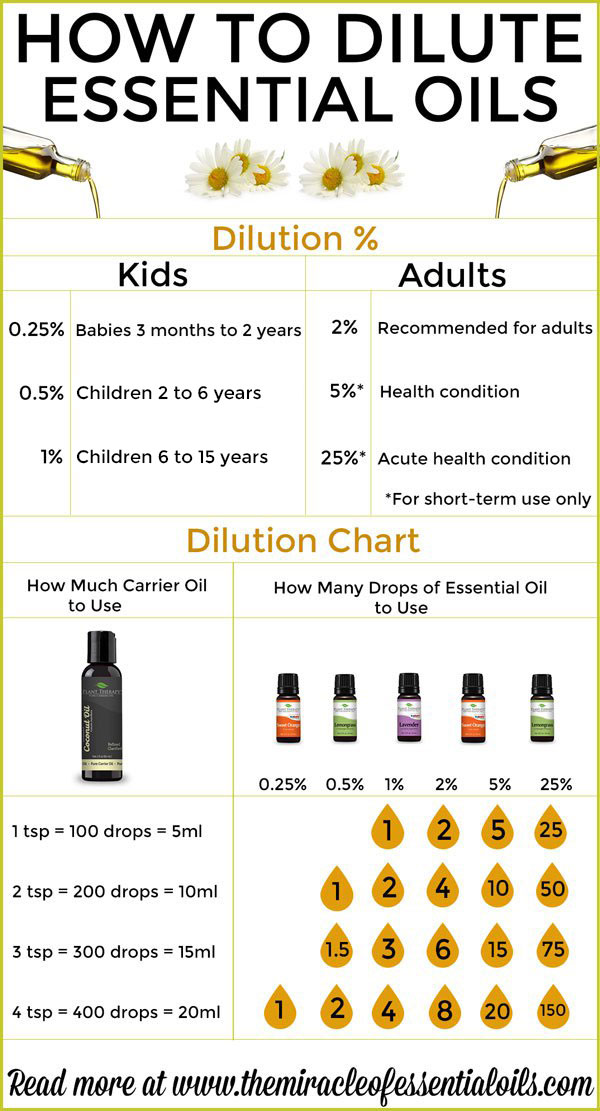If you have essential oils, the first thing you need to learn is how to dilute essential oils safely. Not diluting essential oils poses many risks, which you can easily avoid by learning a few guidelines on how to dilute them.
Why Do You Need to Dilute Essential Oils?
Essential oils, as you may already know, are potent plant extracts that are derived from pressing/distilling large amounts of plant matter. They are extremely concentrated. To give you a better idea, 1 drop of rose essential oil contains the equivalent of 40 roses! This means 1 drop contains oils extracted from more than 1200 petals. That’s how concentrated they are, and using essential oils directly onto the skin is not only absurd, it can be very dangerous.
Dangers of Not Diluting Essential Oils
If you search for it, you’ll find many horror stories that arise from not diluting essential oils properly. Using essential oils only after properly diluting them is the smart and responsible thing to do, whether it is on yourself or your family.
Here are some of the dangers of not diluting essential oils properly:
- Skin burns – Some oils are very potent and can give you chemical burns when applied undiluted or improperly diluted on the skin.
- Irritation – Not diluting essential oils can lead to irritation of the skin. It also increases the chances of getting into the eyes or mucosal membranes and irritating them. Direct application can lead to permanent or temporary damage of corneal tissue in the eyes or mucus membranes.
- Sensitization – Sensitization is a type of allergic reaction which occurs through the overuse of essential oils. While skin irritation happens immediately, skin sensitization develops over time and may not be visible until it is too late.
- Wastage – Essential oils are precious and a lot of resources are needed to produce just a few drops. Using essential oils without dilution is not just a waste of resources and money, but is not sustainable or eco-friendly.
Guidelines on How to Dilute Essential Oils
The rate of dilution of essential oils is measured in percentage form. This basically measures how many drops of essential oil to add in 100 drops of carrier oil. For example, 1% dilution means 1 drop of essential oil in 100 drops of carrier oil.

Here are the agreed-upon guidelines on how to dilute essential oils:
» 0.25% Dilution
0.25% dilution rate means adding 0.25 drops of essential oil to 100 drops of carrier oil. Since you cannot measure 0.25 drops, you can achieve this rate of dilution by adding 1 drop of essential oil to 400 drops or approximately 4 teaspoons of carrier oil.
For children between 3 months to 2 years. Prefer to use hydrosols and herbs. For more information, see: Essential Oils and Babies
» 0.50% Dilution
0.5% dilution rate means adding 0.5 drops of essential oil to 100 drops of carrier oil. Since you cannot measure 0.5 drops, you can achieve this rate of dilution by adding 1 drop of essential oil to 200 drops or approximately 2 teaspoons of carrier oil.
For children between 2 to 6 years; only use if absolutely necessary; use when child is sick; prefer to use hydrosols and herbs. For more information, see: Essential Oils and Babies
» 1% Dilution
1% dilution rate means adding 1 drop of essential oil to 100 drops of carrier oil. This means 1 tsp of carrier oil or 6 drops per ounce of carrier oil.
For children 6 to 15 years, pregnant or lactating women; and those with compromised immune systems. This dilution is also appropriate for facial skin.
» 2% Dilution
2% dilution rate means adding 2 drops of essential oil to 100 drops of carrier oil. This means 12 drops per ounce.
This is the recommended rate of dilution for adults and for whole body applications such as body oils, creams and lotion.
» 3% Dilution
3% dilution rate means adding 3 drops of essential oil to 100 drops of carrier oil. This means 18 drops per ounce.
Only for adults; used during a temporary health issue; can be increased up to 10% depending on the ailment in question, age and oil of the adult.
» 25% Dilution
25% dilution rate means adding 25 drops of essential oil to 100 drops of carrier oil. This means 150 drops (or 1.5 teaspoons) per ounce.
Only for adults; only for a short duration; for health issues such as a severe muscle cramp, severe pain and others.
» 100% Dilution
100% dilution means using the essential oil ‘neat’ or ‘as is’ without any dilution whatsoever. Not all essential oils can be applied neat – here are the ones that can be: Essential Oils You Can Use Neat
There are many dangers of applying an essential oil neat and it is not recommended, except in rare cases. Some situations where an essential oil may be used neat include on bug bites, stings or burns on the skin.
Essential oils are used at 100% concentration in inhalers and diffusers.
Top 5 Carrier Oils for Diluting Essential Oils
Here are some examples of carrier oils you can use to dilute essential oils:
1. Coconut oil (where to get it)
2. Olive oil (where to get it)
3. Grapeseed oil (where to get it)
4. Jojoba oil (where to get it)
5. Sweet almond oil (where to get it)
Essential oils can also be diluted using emulsifiers, such as milk, honey and yogurt (for ingestion) and aloe vera gel for topical application. For more information, read: Emulsifying agents for essential oils.
Do you follow essential oil dilution rules when using essential oils? Comment below!
